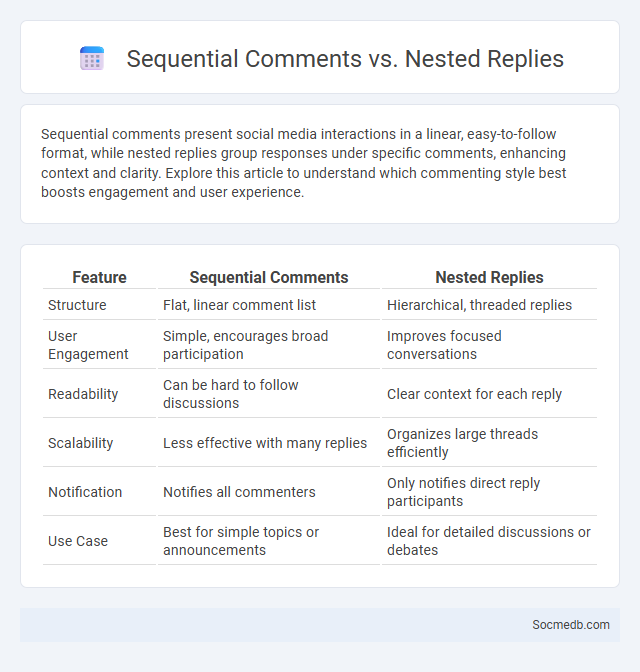
Photo illustration: Sequential Comments vs Nested Replies
Sequential comments present social media interactions in a linear, easy-to-follow format, while nested replies group responses under specific comments, enhancing context and clarity. Explore this article to understand which commenting style best boosts engagement and user experience.
Table of Comparison
| Feature | Sequential Comments | Nested Replies |
|---|---|---|
| Structure | Flat, linear comment list | Hierarchical, threaded replies |
| User Engagement | Simple, encourages broad participation | Improves focused conversations |
| Readability | Can be hard to follow discussions | Clear context for each reply |
| Scalability | Less effective with many replies | Organizes large threads efficiently |
| Notification | Notifies all commenters | Only notifies direct reply participants |
| Use Case | Best for simple topics or announcements | Ideal for detailed discussions or debates |
Defining Sequential Comments
Sequential comments on social media refer to a series of user-generated responses posted in a specific order under a single post, enabling organized conversations. These comments create a clear narrative flow by linking replies directly to previous messages, enhancing user engagement and context clarity. Platforms like Facebook, Instagram, and LinkedIn implement sequential commenting to facilitate easier tracking of discussions and promote interactive dialogue among users.
Understanding Nested Replies
Understanding nested replies enhances your social media interactions by organizing conversations hierarchically, making it easier to follow discussions within comment threads. This structure allows for clearer communication and efficient engagement, as responses remain contextually tied to specific messages. Utilizing nested replies improves your ability to participate in complex dialogues and fosters more meaningful online interactions.
What is a Comment Thread?
A comment thread is a series of replies or messages linked under a single post on social media platforms, allowing users to engage in focused discussions. It organizes interactions by grouping comments and responses, enhancing the clarity of conversations and making it easier for you to follow specific topics or questions. Comment threads increase engagement by fostering dialogue and providing context within social media communities.
User Experience Across Comment Structures
User experience across comment structures significantly impacts social media engagement and satisfaction. Optimized comment threads with clear nesting and easy navigation enhance readability, fostering meaningful interactions and community building. Your platform's ability to streamline responsiveness and minimize clutter drives deeper user involvement and sustained activity.
Navigability: Linear vs Hierarchical Discussion
Navigability in social media platforms significantly impacts user experience and content discovery, with linear navigation offering sequential, timeline-based browsing, while hierarchical navigation provides categorized, topic-driven exploration. Your ability to efficiently find relevant posts depends on whether the platform emphasizes chronological order or organized data structures, influencing engagement and information retention. Understanding the differences in these navigability models can help optimize your social media strategy for better interaction and content management.
Impact on Conversation Clarity
Social media platforms often reduce conversation clarity due to character limits and rapid information exchange, leading to oversimplification and misinterpretation of messages. The prevalence of slang, emojis, and abbreviations further complicates understanding, causing ambiguity in digital communication. Algorithms prioritize engagement over nuance, amplifying polarized and unclear conversations across networks like Twitter and Facebook.
Moderation Challenges in Different Formats
Moderation challenges vary significantly across social media formats, with text-based platforms struggling to detect nuanced hate speech while video content requires advanced AI for real-time analysis of visuals and audio. Live streams present unique difficulties due to the immediacy and unpredictability of content, often necessitating human moderators alongside automated systems. Your experience on social media depends on effective moderation strategies tailored to the specific content format to ensure a safer online environment.
Community Engagement and Participation
Social media platforms drive community engagement by facilitating interactive conversations and enabling users to share content, opinions, and experiences in real time. Features like comments, likes, shares, polls, and live streams enhance participation and create a sense of belonging among diverse online audiences. Effective community management leverages these tools to build trust, foster loyalty, and encourage sustained user involvement.
Platform Examples: How Sites Implement Each System
Social media platforms implement various systems to enhance user engagement and content discovery; for instance, Facebook uses an algorithm that prioritizes posts based on relevancy and user interactions, while Instagram relies heavily on machine learning to curate personalized feeds through image recognition and user behavior analysis. Twitter employs real-time trending topics and hashtag systems to organize conversations and surface timely content, whereas LinkedIn integrates professional network algorithms to promote relevant job postings and industry news. Understanding how these platforms tailor their systems can help you optimize your social media strategy for better visibility and interaction.
Choosing the Right Comment Structure for Your Platform
Selecting the optimal comment structure on social media involves understanding platform-specific features, such as nested threads on Facebook or flat comments on Twitter. Tailoring the format to match user interaction patterns enhances engagement and clarity, especially when managing brand or community conversations. Analyzing analytics data helps identify which comment styles encourage meaningful discussions and improve overall social media presence.
 socmedb.com
socmedb.com